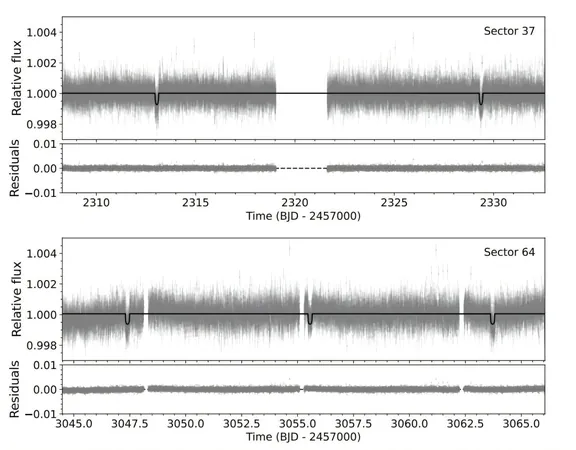
Astronomers Discover Massive New Exoplanet That's Three Times the Size of Earth!
2025-04-23
Author: John Tan
NASA's TESS Hits the Jackpot Again!
In an exciting breakthrough, NASA’s Transiting Exoplanet Survey Satellite (TESS) has uncovered a remarkable new sub-Neptune exoplanet, named TOI-3493 b, orbiting a brilliant G-type star. This stunning discovery reveals a planet that dwarfs Earth, boasting a size over three times larger and a mass nearly nine times that of our home planet!
The Wonder of TOI-3493 b Revealed!
The findings, revealed in a research paper on April 17, show that TOI-3493 b is part of a growing list of over 7,500 candidate exoplanets discovered by TESS since its launch in April 2018. So far, 620 of these have been confirmed, as the satellite meticulously scans around 200,000 of the brightest stars in our vicinity for transiting worlds, ranging from small rocky planets to immense gas giants.
Get to Know TOI-3493!
Located approximately 315 light years away, TOI-3493, also known by its catalog number HD 119355, is a G1/2 V type star. A dedicated team led by astronomer Priyanka Chaturvedi from the Thuringia State Observatory Tautenburg spotted a remarkable transit signal in the star's light curve while analyzing data from TESS, which was later confirmed through further ground-based observations.
What Makes TOI-3493 b Special?
TOI-3493 b is not only intriguing for its size and mass—about 3.22 Earth radii and 8.97 Earth masses—but also for its estimated bulk density of 1.47 g/cm³. The planetary body completes an orbit around its star every 8.16 days, with an equilibrium temperature estimated to reach around 1,102 K!
A Water-Rich World?
Scientists speculate that TOI-3493 b could be a water-laden world. The planet may possess a significant core primarily composed of silicates and water, cloaked in a thinner layer of hydrogen, or it might have a denser rocky core enveloped by a thicker hydrogen atmosphere.
A Leading Candidate for Future Studies!
With its impressive transmission spectroscopy metric (TSM) of approximately 110, TOI-3493 b stands out as the second-most favorable candidate for future transmission spectroscopy studies, right behind HD 191939 b.
Meet Its Star, TOI-3493!
The host star TOI-3493 boasts a radius of about 1.23 times that of the Sun, with its mass comparable to our star. Aging at around 7.3 billion years, this star has an effective temperature of 5,844 K and a relatively long rotational period of 34 days, indicating that it is quite inactive.
This discovery opens new avenues in the quest for understanding alien worlds and the formation of planetary systems—who knows what else TESS will reveal next!
 Brasil (PT)
Brasil (PT)
 Canada (EN)
Canada (EN)
 Chile (ES)
Chile (ES)
 Česko (CS)
Česko (CS)
 대한민국 (KO)
대한민국 (KO)
 España (ES)
España (ES)
 France (FR)
France (FR)
 Hong Kong (EN)
Hong Kong (EN)
 Italia (IT)
Italia (IT)
 日本 (JA)
日本 (JA)
 Magyarország (HU)
Magyarország (HU)
 Norge (NO)
Norge (NO)
 Polska (PL)
Polska (PL)
 Schweiz (DE)
Schweiz (DE)
 Singapore (EN)
Singapore (EN)
 Sverige (SV)
Sverige (SV)
 Suomi (FI)
Suomi (FI)
 Türkiye (TR)
Türkiye (TR)
 الإمارات العربية المتحدة (AR)
الإمارات العربية المتحدة (AR)